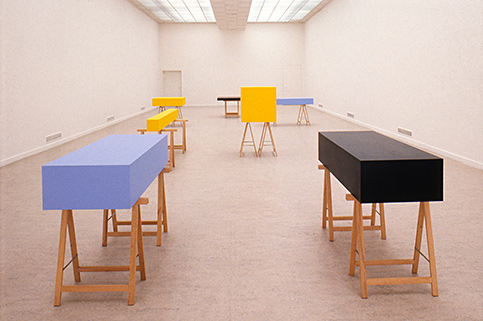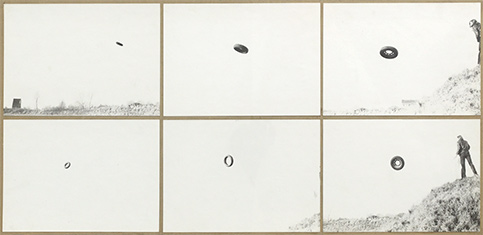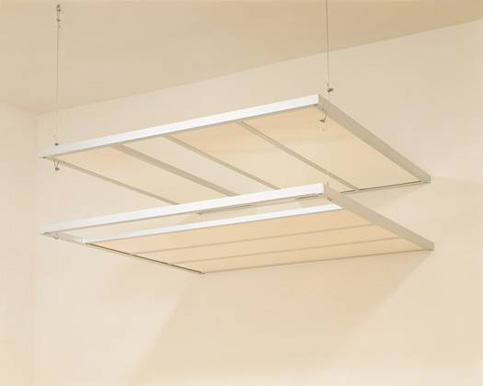|
12 March – 22 May 2016
Philippe Van Snick
The Grazer Kunstverein kicks off its 30th anniversary program with a large solo exhibition by Belgian artist Philippe Van Snick (b. 1946, Ghent) as a continuation of its exploration into notions of social abstraction. The exhibition spans almost five decades and traces developments in the artist’s highly consistent body of work, best known for its post-minimalist approach to painting. The exhibition is the artist’s first in Austria.

Philippe Van Snick
‘Instability of Fundamentals’, 1990
wood, vinyl paint and trestles
Courtesy the artist and Tatjana Pieters
In the 70s, Van Snick developed an interest in systematic methodologies that lead him to formulate a consistent color and numeral system. This allowed him to create a steady body of work in the following decades. For the artist, light and color are both scientific, objective descriptions as well as subjective codes inspired by our everyday experience. The concept of time, specifically the dualism of day and night and the lightness and darkness that signifies its passing, is often explored in works that underline the experiential relationship between the viewer and his/her surroundings. By finding itself within the realm between painting and sculpture, the predominant concerns of modernism are invoked by questioning the autonomy of the artwork and geometric abstraction as a universal language.
The artist’s early conceptual photography and film works form the backbone for the exhibition in which everyday observations are abstracted and formalized. Through early studies and explorations into form, space and dynamics the exhibition unfolds into Van Snicks in-depth dedication to cosmology and the rhythms of daily life through color and shapes, starting in the mid 80’s. The large-scale installation Instability of Fundamentals (1990) takes over one the main galleries and functions as a sculptural representation of the series entitled Asymmetrische Dag en Nachtreeks (1987–1989). In 1984, the artist began to work with the duality of the phenomenon “day” and “night” which was symbolically represented by a light blue and a black rectangle that always occur together. Since then, he has developed an important series of works in which reduced reality through abstraction underlines the fundaments of daily life. The work Instability of Fundamentals pushes this notion further by reflecting upon cosmology through a constant rearrangement of single particles. The artist’s interest in the relation between scale, volume and the viewer is accentuated with a series of works such as Territorium (1990), Punt (1992) and Groot Vertikaal (1999), which through a simple form symbolizes human scale and perception. The earlier work Indifférence orbitale (1979) takes over most of the back gallery and consists of one hundred gouache paintings on paper representing lozenges painted different colors and elongated into various configurations; these shapes are derived from a series of photographs showing the back of a house partially covered by a colorful sheet stretched out like an awning and understood to be the model for the gouaches.
Philippe Van Snick’s solo exhibition is co-organized with De Hallen Haarlem (NL) where a complementary show of his work is currently at display (16 January – 16 May 2016). For the occasion of these exhibitions, Van Snick has produced an artist’s edition, which can be acquired for 50 Euros at both institutions.
The exhibition of Philippe Van Snick at De Hallen Haarlem and Grazer Kunstverein is generously supported by Flanders Agency for Arts and Heritage.
The Members Library* presents
Philippe Van Snick – Studies

Philippe Van Snick
‘Autoband’, 1971
black-and-white photographs on glossy baryt paper, cardboard, glue
6 x (10 x 14 cm), unique
Courtesy the artist and Tatjana Pieters
As introduction to the exhibition, The Members Library presents Philippe Van Snick’s notebooks and sketches, which illustrate his exploration into the illusion of ‘perfect’ shapes such as circles and shapes but also the physical understanding of found daily routines or situations. In 1970 he published a definition of the ellipse that underlines his fascination for this dynamic phenomenon. He writes “The ellipse is a conical section without (real) asymptotes and with an eccentricity E = C : A < 1; for C = E = O it becomes a circle”. Around the same time, the ellipse became a crucial shape in the various media applied by the artist, whether through photography, film or drawing. In his notebooks, one can see the artist slowly developing a code in order to abstract reality. The models in the exhibition are sketches in order to relate color and shape to scale and volume.
*The Members Library is constructed and designed by the artist Céline Condorelli (b. 1974, France) in collaboration with Harry Thaler as a permanent work entitled Things That Go Without Saying. The structure built for The Members Library is part of a series entitled Additionals. These different prop-like objects and quasi-functional structures operate at a scale between furniture and architecture.
On display continuously
Ian Wilson
1 February 2013 –
Ian Wilson (b. 1940, South Africa) is an artist whose work bears a powerful resemblance to the Kunstverein’s own mission: to explore the relationship between the viewed – or discussed – and the viewer, and the urgency involved in these interactions.
Wilson has been exploring spoken language as an art form since 1968. He has described his own work as “oral communication” and later as “discussion.” At Wilson’s own request, his work is neither filmed nor recorded, thereby preserving the transient nature of the spoken word. Wilson’s earlier artistic explorations took place entirely in monochrome. He was absorbed by questions relating to perception and painting. The works were indebted to the innovations of Minimal Art in the late 1950s and early 1960s with its distillation of painting to nonrepresentational self-reflectivity and stripping of sculpture to the bare bones of industrially fabricated geometric form without determinable metaphoric content.
Wilson’s last physical objects, Circle on the Floor and Circle on the Wall, were created in early 1968. By making these works, Wilson realized that it was not necessary to produce an object to visualize a concept.
To highlight his importance to the program, the Grazer Kunstverein has devoted a permanent solo exhibition to Wilson’s work. The show presents different works throughout the years as well as a permanent display of a commissioned and acquired Discussion. This discussion on the pure awareness of The Absolute took place at the Grazer Kunstverein on the 4th of May between the artist, current staff, and previous directors of the Grazer Kunstverein since 1986.
On display
‘Discussion (Grazer Kunstverein)’, 2013
Donated by Stefan Stolitzka for the collection of the Grazer Kunstverein
The Peacock
1 February 2013 –
The Grazer Kunstverein continues to examine its interior by introducing (new) furniture, design, and applied and decorative arts that analyze their own functionality. The Peacock, as this non-stop group show is titled, is inspired by the notion of a Period Room, a room that defines a moment in time, as well as the animal itself, one that represents internal and external pride. A group of artists will be invited to contribute works to enhance the functioning space of Grazer Kunstverein with design pieces and conceptual interventions. (Parts of) these works will reappear and be juxtaposed alongside others in upcoming solo exhibitions and will therefore form the backbone and interior of the Kunstverein.
On display
12 March – 22 May 2016
Plamen Dejanov & Swetlana Heger*
Known for their collaborative projects exploring the relations between art and economic processes, Plamen Dejanoff and Swetlana Heger made their appearance on the European scene in the mid 1990s. Both artists approached their collaborative works as vessels for critical strategy. Their most notable project together was Quite Normal Luxury, 1999, a piece that consisted largely of a contract with BMW that traded brand exposure for the artists’ use of a new Z3 Roadster. In order to reach a new form of dialogue with the business world, they signed an exclusive contract with the “cultural” sponsorship department of the international headquarters of BMW, stipulating that they would use only communications material originated by the Bavarian automaker for their exhibitions and publications. In exchange for this they were given a Z3 Roadster as a working tool and, at the same time, a de facto part of their collection.
For several years since they part ways, Dejanov changed his name back to Dejanoff and developed his own complex projects, which explore history and heritage.
Josh Faught
‘Dale, Tony, Bob, and Henry’, 2015
For the entrance of the Grazer Kunstverein, Josh Faught (b. 1979, US) developed a bronze plaque, which displays the names Dale, Tony, Bob, and Henry. The work began as a question. What does it mean to summon a common American male’s first name? How might this simple form of summoning act as a way to render someone or something visible and how does this work exist as a corporeal surrogate? “Dale, Tony, Boy, and Henry,” which co-exists with an entire series of “named” work, extended from the artist’s interest in queer archival material. Within these archives, it’s easy to find men’s names appearing side by side, at once as a way to conjur desire in the form of “trick” lists, as a memorial in the form of the NAMES project, or as a means of support in the unique ways that gay men forge intimacy and connection with each other.
Courtesy of the artist, Grazer Kunstverein, and Gallery Lisa Cooley, New York
Liam Gillick*
‘Discussion Island Dialogue Platform’, 1997

Liam Gillick
‘Discussion Island Dialogue Platform’, 1997
two parts
Anodized Aluminium, Plexiglas, cables, fittings
Courtesy Galerie Esther Schipper
Liam Gillick deploys multiple forms to expose the new ideological control systems that emerged at the beginning of the 1990s. He has developed a number of key narratives that often form the engine for a body of work. McNamara (1992 onwards), Erasmus is Late & Ibuka! (1995 onwards), Discussion Island/Big Conference Center (1997 onwards) and Construction of One (2005 onwards). Gillick’s work exposes the dysfunctional aspects of a modernist legacy in terms of abstraction and architecture when framed within a globalized, neo-liberal consensus. His work extends into structural rethinking of the exhibition as a form.
At the Grazer Kunstverein, Gillick presents a double layered platform originally designed for the exhibition ENTERPRISE at the ICA in Boston. The work designates a space where it might be possible to reconsider the potential of dialogue.
Courtesy Esther Schipper
Nicolás Paris
‘Portable Garden’, 2009–2013
Coming from an architectural background, Nicolás Paris (b. 1977, Colombia) often draws on pedagogical strategies to incorporate elements of collaboration, dialogue, and exchange in his work. In order to develop events and places, which encourage the exchange of reflections, Paris’ work is oriented to create dialogue environments for the observer, the exhibition space, and the institutions.
Paris’ Portable Garden consists of a green pencil, with the eponymous words engraved in it. The pencil is used by the staff to mark the number of visitors coming to the Grazer Kunstverein during the period of the exhibition.
Courtesy of the artist and Galeria Luisa Strina, Sao Paulo.
Will Stuart
‘On the positioning of a replica of Michelangelo Pistoletto’s Struttura per parlare in piedi (Structure for talking while standing) 1965–66, from the series Oggetti in meno (Minus objects) reproduction’, 2012
Positioned wherever negotiated, Will Stuart (Will Holder and Stuart Bailey) present a replica of Struttura per parlare in piedi, a work by Michelangelo Pistoletto (b. 1933, Italy) that belongs to his series of Minus Objects.
The work is accompanied by a public notice investigating the original intentions behind the work, and how subsequent negotiations with the various parties involved reflect its ambiguous doubling as furniture (for the public to lean on) and metaphor (for the politics of conversation). The object is an ongoing source of friction during the consideration of space and function within discursive programming.
An exhibition of Michelangelo Pistoletto’s work was organized at the Grazer Kunstverein in 1988.
Courtesy of the artists
*New additions
|
![]()
![]()